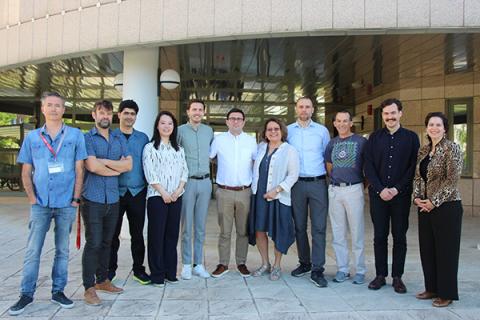ICMM hosts Neuropic's Kick-off meeting, a European project with a 3M€ budget
Eleven researchers have met to start this project whose aim is to create a network of artificial neurons exploiting thermal energy from the devices themselves.

The Materials Science Institute of Madrid (ICMM), CSIC, hosted on April, 26th and 27th, the kick-off meeting of Neuropic, a project that has received 3 million euros through Pathfinder grants from the European Union. The project, which officially started on March 1st and has an estimated duration of four years, will create artificial neural networks that will be used in integrated photonic circuits. It has the participation of two Universities (the Technical University of Denmark and the University of Cork (UK)), two Spanish Research Institutes (ICN2 and ICMM, CSIC), and two small medium-sized companies (Beamfox and Fincotec) from four different EU countries (Denmark, Ireland, Germany, and Spain).
The attendees at this meeting are the researchers Cefe López Fernández, David García Fernández, Shulamit Edelstein and Gloria González from ICMM-CSIC; Clivia M. Sotomayor Torres from the Institut Català de Nanociencia i Nanotecnologia (ICN2); Babak Vosoughi Lahijani, Søren Stobbe, and Bingrui Lu from the Danmarks Tekniske Universitet (DTU); Moritz Seyfried from Fincotec; Lasse Frølich from Beamfox, and Padraic Morrissey and Matt Hall from Tyndall National Institute.
David García, researcher at ICMM and project coordinator, has welcomed all the visitors emphasizing the importance of their project to make a more sustainable artificial intelligence. The Spanish centers will work more on the design and characterization of these complex photonic systems, while Denmark's partners will manufacture the first prototypes (which will be studied again in Spain). For their part, the partners from Ireland and Germany will collaborate with the DTU in the development and manufacture of the final prototype of the system.
These researchers will imitate in electronic devices how the human brain works through a complex system of interconnected neurons. It is what is known as neuromorphic computing, an alternative way of processing information different from that of standard computers or mobile phones. They will also do so with a new and sustainable approach: "We propose using thermal energy from the system to create this type of artificial neurons," said García when the project was public.
"We propose using the thermal energy that these structures already have at room temperature to create the functionalities of the neuronal system," explained the researcher, adding: "As they are tiny systems, they vibrate at room temperature. These vibrations are generally harmful to other types of applications, but we intend to take advantage of them and exploit them in our network of neurons.
All of this, moreover, will be carried out with silicon, a very abundant material in nature and whose associated technologies are highly developed, which also implies less damage to the environment.
An international nanotechnological project
Neuropic involves "some of the world's leading researchers and companies in nanotechnology, photonics, advanced manufacturing, and complex systems in a risky and highly interdisciplinary research project with the ambition of founding a new paradigm of programmable silicon photonics," says the researcher. From his point of view, "nanotechnology is now ready to begin exploring programmable photonic chips scaled to thousands of programmable nodes."
The scientific team has some idea of what a neuron is: "That is our proposal, but we have to manufacture it and characterize its properties in the laboratory," García emphasizes. The final objective will be to create a complex network of these neurons connected to each other and check how they react to the information introduced by photons too, in this way, "demonstrate that this network can solve Artificial Intelligence algorithms", points out García, a researcher with extensive experience in complex photonic systems.
"I find it very interesting to create artificial neural networks to test questions about complex systems and emerging processes," says García, who concludes: "This will translate into a way of solving all those algorithms that no longer depend on us, but energetically much more efficient. That's what these kinds of projects are for, to find much more sustainable ways of solving problems."
-- Ángela R. Bonachera - ICMM Communication Unit --
Instituto de Ciencia de Materiales de Madrid (ICMM)
Sor Juana Ines de la Cruz, 3
Cantoblanco, 28049
Madrid, España
Telephone: (+34) 91 334 90 00
Email: @email
Communication Office: @email

Acknowledge the Severo Ochoa Centres of Excellence program through Grant CEX2024-001445-S/ financiado por MICIU/AEI / 10.13039/501100011033

Contacto | Accesibilidad | Aviso legal | Política de Cookies | Protección de datos